
The first step in the ecommerce SEO process is Shopify keyword research.
For this tutorial, I will use a fictional mens underwear brand.
As we learnt earlier, your SEO keywords are the words and phrases in your website that make it possible for users to find your store using search engines.
For example, someone who wants to buy toys for their pets may search for pet toys, dog toys, cat toys, toys for pets, toys for dogs, toys for cats, etc.
Keywords can be defined and should be chosen based on a few different attributes:
Let’s dig in:
Keywords should also be chosen with regards to intent. People who search for specific keyword phrases typically have one of two intentions.
Another important thing to consider when doing keyword research is the competition for the keywords you are interested in targeting.
PRO TIP: If a keyword has Google shopping ads listed at the top or the side of the page then it is likely a commercial intent keyword. As people are willing to pay for that traffic an can make profit from it.
While some keyword research tools will give you a rating (low – medium – high) or score to help you determine the competition level for particular keywords, the easiest way to see who you would be up against in search results is to simply search for those keywords in search engines and see who ranks on the first page for them.
PRO TIP: Use searchlatte.com when searching for keywords. This tools allows you to choose to see the search results from a specific country and allows you to stop your search history from affecting the results.
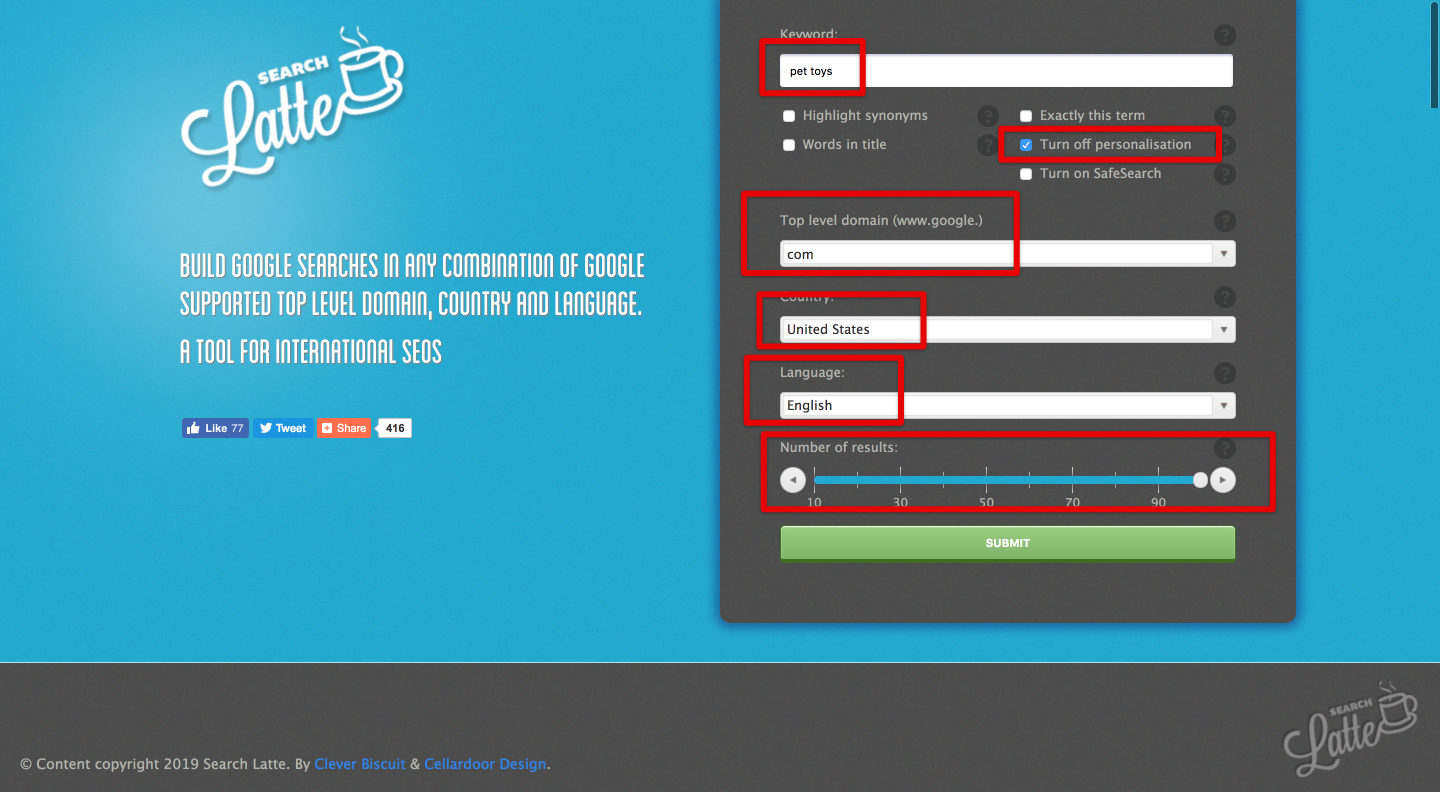

Above, you can see that the competition for pet toys is strong.
First, you are competing against Google Shopping ad campaigns, which allows advertisers to put their products right on the first page of search results. As we learned earlier this is SEM.
Next, you are competing against big brands like PetSmart. Chewy, Petco, and Amazon.
While not impossible (depending on the time and money you have to devote to your search engine optimization strategy), outranking established brands like these using broad keywords will be extremely difficult. Therefore, pet toys would be considered a keyword with a high level of competition.
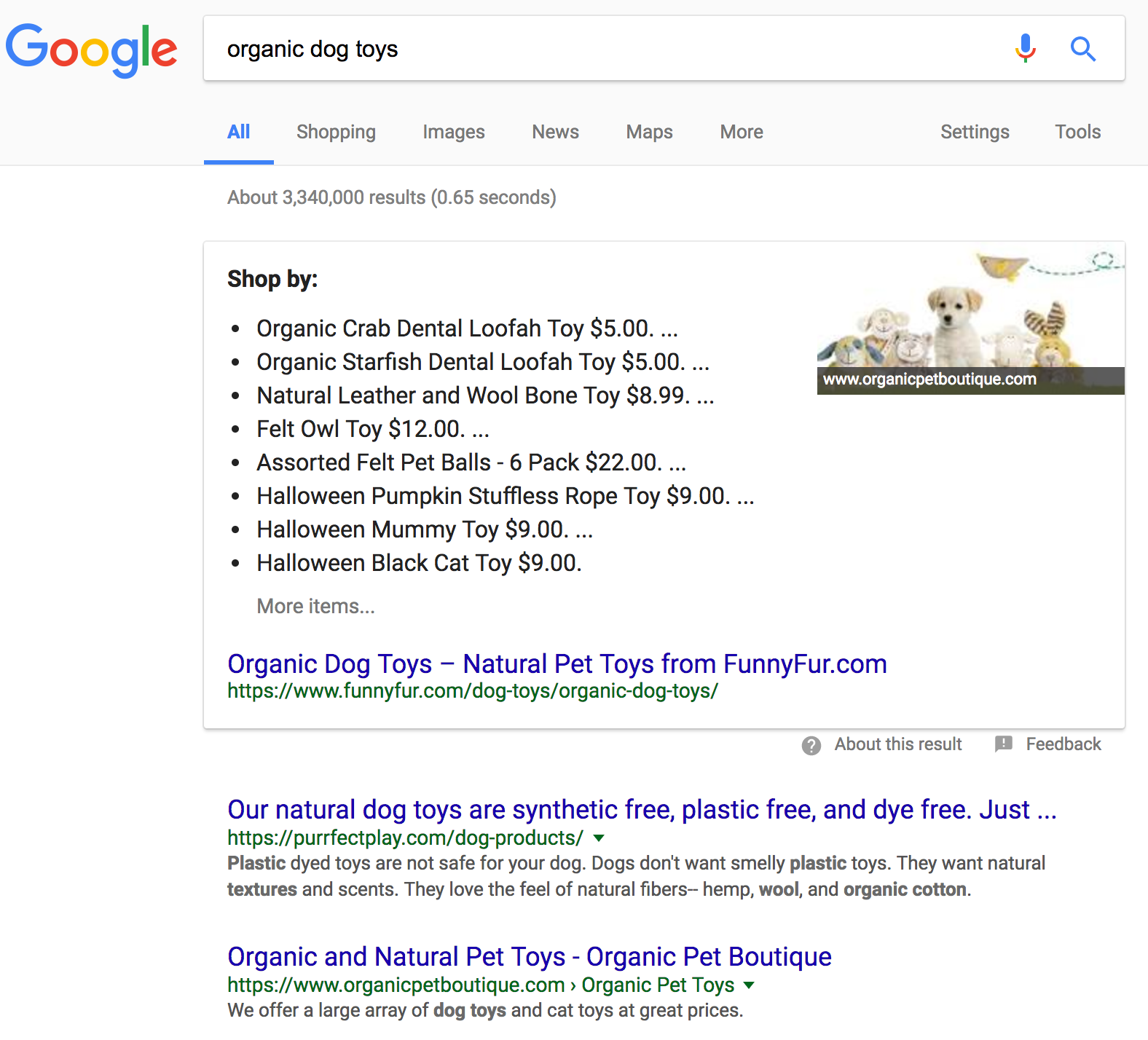
Alternatively, if you look at the above example for organic dog toys, you can see that the major brands are no longer at the top of search results.
And neither are the Google Shopping ads, which in this example, are to the right of the search results.
Fewer people may search for organic dog toys when compared to the search volume for pet toys.
But thanks to the more specific keywords, you can almost guarantee the people who perform a search for organic dog toys have strong commercial intent for a specific type of product.
And while the websites that appear first in the above search results are still strong domains in terms of domain authority and PageRank, they do not have the high authority that established brands would have.
Hence, it would be easier to rank well on the first page of search results against these domains versus PetSmart. Chewy, Petco, and Amazon.
Therefore, organic dog toys would have a lower level of competition compared to pet toys.
The best part about more specific, long-tail keyword phrases is that you can optimize specific and broad keywords simultaneously.
NB: However this is changing with the rise of voice search, more on that in the advanced Shopify SEO strategies.
We’ll go into more practical detail on how to determine long and short tail keywords, keyword intent, volume and competition in the next section.
Let’s get started with the how-to section.
Before you start your keyword research you want to compile all your products and collections into a Google sheet.
This will then allow you to see how many product and collection keywords you need to find.
We’ll also find and chose a keyword for your homepage too.
Any informational intent keywords we find we can save into a special list for your blog, we’ll then learn how to prioritize those keywords for your blogs content plan.
The easiest way to do this would be to simply export them from Shopify.
Jump into your Shopify admin, click:
Products > all products > then ‘Export’

Then choose ‘all products’ and ‘plain csv file’.

Then CSV file will be emailed to your Shopify account email address.

NB: If you don’t have products or you’re just starting a new ecommerce website, like a dropshipping store, then your keyword research can inform the products you choose to add to the store.
Create a blank Google sheet.
[Here is a link to a Google Sheet template we made, you can simply click ‘File’ and ‘Make a Copy’ and the template will be copied to your Google Drive root folder where you can edit it and save it for later.]
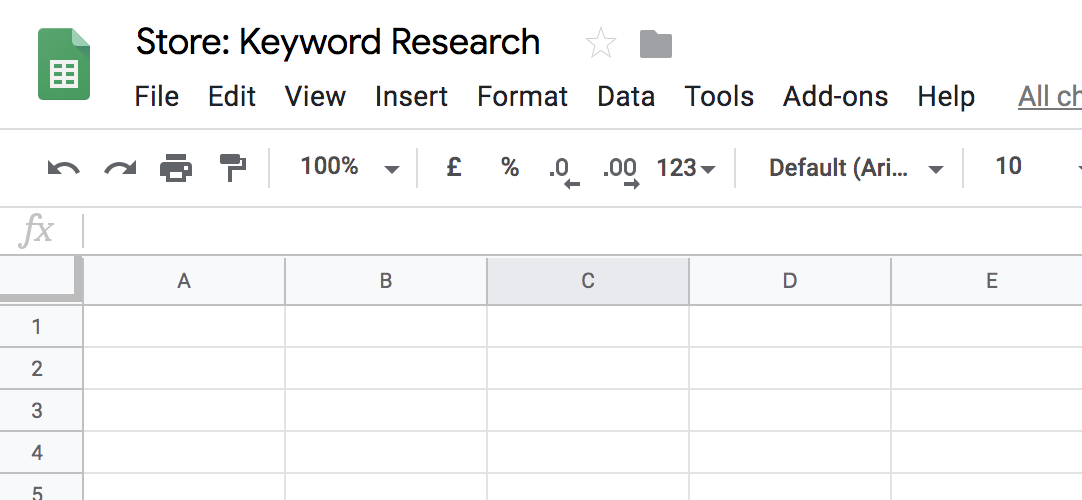
Next, add 3 tabs to the bottom of the sheet, we’ll collect and organise your keywords in these tabs.

In the ‘Potential keywords’ tab add in these headers.

We’ve added in headers that match some of the keyword attributes we learned about earlier.
Now we have a place to save all our keyword ideas.

Then copy all the individual products from your CSV file and paste them into the ‘Chosen keywords’ tab.
Just copy and paste the ‘handle’ and ‘title’ tab into your ‘Chosen keywords’ tab. You want to add in the SKU column too so you have a unique identifier for each product if you get confused.
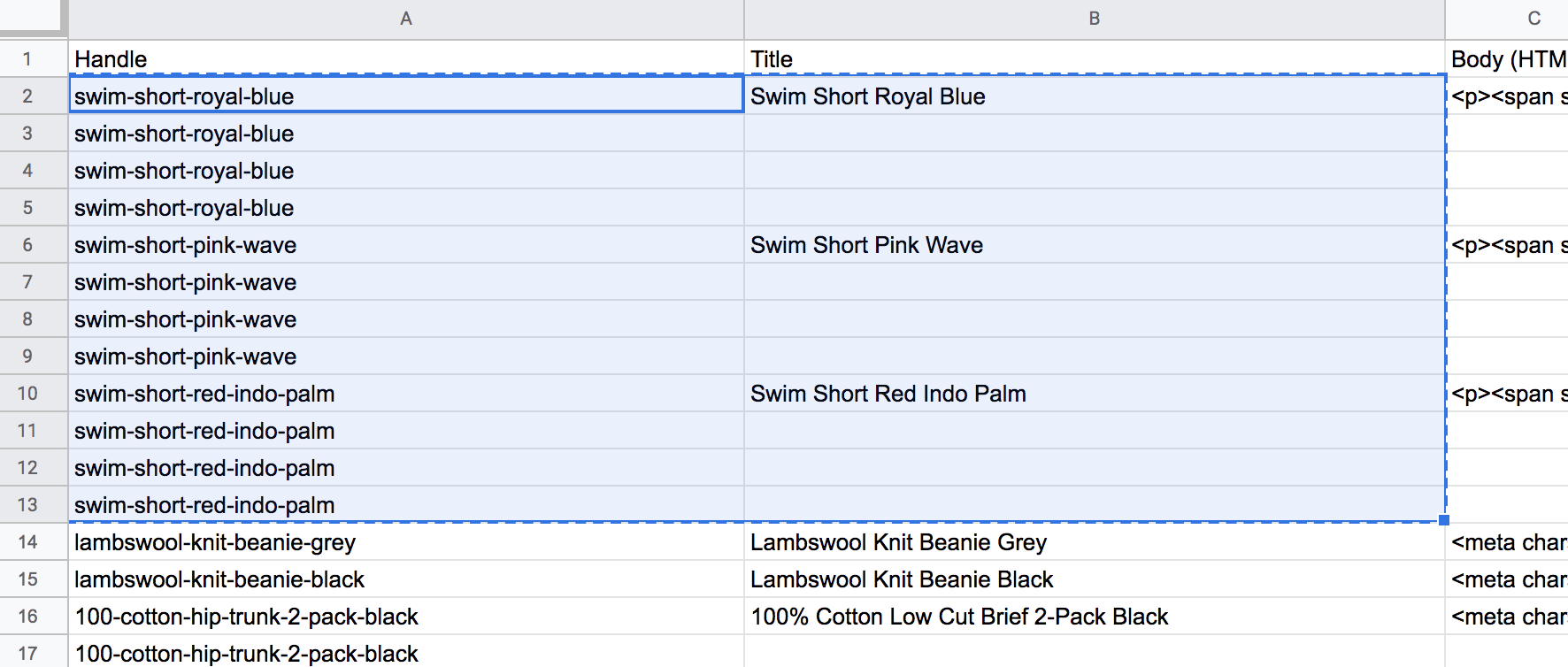
Here is an example of what it might look like.

You’ll need to manually add in collections and one row for your homepage.

It is better to keep a row for every SKU then we can paste your update info back into your product sheet and re upload to Shopify without too much hassle and manual reorganizing.
Once we complete our keyword research, we’ll choose keywords and match them to your homepage and product and collection pages.
Now we are ready for some keyword research!
Let’s load up some SEO tools to help with the research.
In the interest of keeping this process simple, practical and actionable. I’m not going to use every tool and follow every possible keyword research process.
Instead, like the Pareto principle, I will rely on 20% of tools and process that bring in 80% of the keywords we need.
The tools and websites we’ll use for our keyword research process are:
Google suggest aka Keywordtool.io
The first step is to choose your #1 short-tail keyword. The keyword that best represents your ecommerce category.
For example, in this tutorial, we are working on our imaginary mens underwear Shopify store. We sell briefs, boxer briefs and straight-up boxers.
The first keyword I will type into Google is ‘mens underwear.’

As soon as I start typing, Google suggest creates a list of long-tail and related keywords.
The quickest and easiest way to get all these lovely keywords in your sheet is to jump over to keywordtool.io.
This tool will also find suggestions that don’t necessarily begin with the phrase but simply include it, Google suggest only does this sometimes.
Pop in the keyword and see the results. The tool found 450 keywords! Wow, great start.

Make sure to check the country and language you selected.

Now you can copy them and paste them into your spreadsheet in the ‘All keywords’ tab.


You can now repeat this process for each of your category pages.
Our three main category pages are, ‘mens briefs’, ‘mens boxer briefs’ and ‘mens boxers’.
You can search for a few variations for example, ‘mens underwear briefs’ or simply ‘mens briefs’.
Next you want to repeat the process for your most important product SKUs or all of them if you only have a few.
The point of product keyword searches is to find color, size and other modifier variations.
For example we sell ‘Black mens short-cut boxer briefs’.
‘Black’ is a color modifier, ‘short-cut’ is a style modifier. You can also use price modifiers like ‘cheap’ or ‘high-end’.
Material types are also typical product keywords variations in ecommerce.
For example ‘Cotton button down shirt’.
This can be taken further to describe the material, ‘100% Organic cotton’.
The list of modifiers here is more or less endless depending on the niche of ecommerce store. So really dig into what differentiates your product, whether it be price, quality or something simple like free next day delivery. Then look for variations of your core product keywords with those modifiers added.
Again, add any keyword ideas that Keyword Tool creates to the ‘All keywords’ tab and then move onto the next section.
Google related searches
Google offers a section of related keywords for search users who do not find the content they want. You can search for your #1 short-tail keyword on Google and scroll down to the bottom of the first page of search results to see these related keywords.

You can also click on these searches and look at their related searches. I recommend doing that for your short-tail and collection page keywords. Then paste the results into the sheet in the ‘All keywords’ tab.

Don’t worry if your sheet looks messy like this when you paste, I will show you how to remove duplicate keywords and empty rows with Google sheet add-ons later in the guide.
Google keyword planner
Google offers a powerful keyword research tool inside of Google Ads called the Google Ads Keyword Planner. If you’ve never used Google Ads, you will need to create an account using your current Google account or a new Google account.
One of the tricky parts of setting up a new Google Ads account is the setup wizard. If you start it by entering your email and website information in the form below, you will have to create your first Google Ads Ad and enter your billing information before you can access Google Ads Keyword Planner. To bypass this when creating a new account, be sure to click the ‘Create an account without a campaign’ link above the form asking for your email address and website.
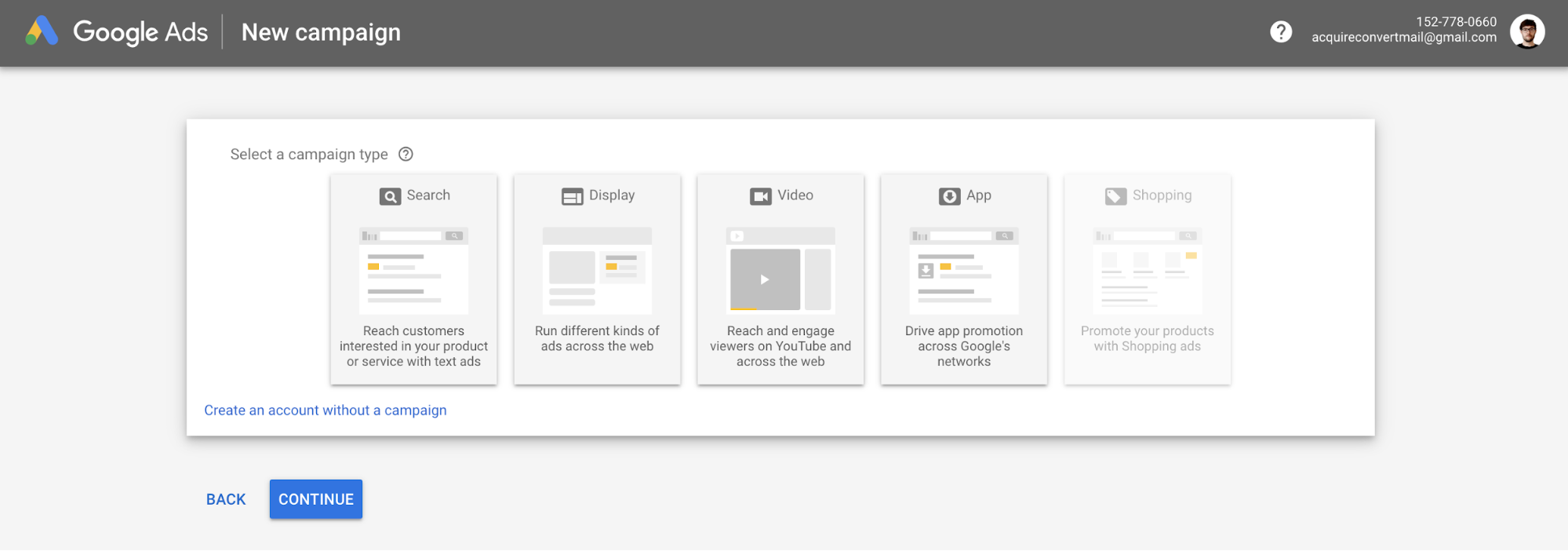
Clicking on the link will take you to an account setup page that only requires you to enter some basic location and time zone information without having to create an ad or enter your billing information. From there, you will be able to access the Google Ads Keyword Planner from the tools menu or this link.



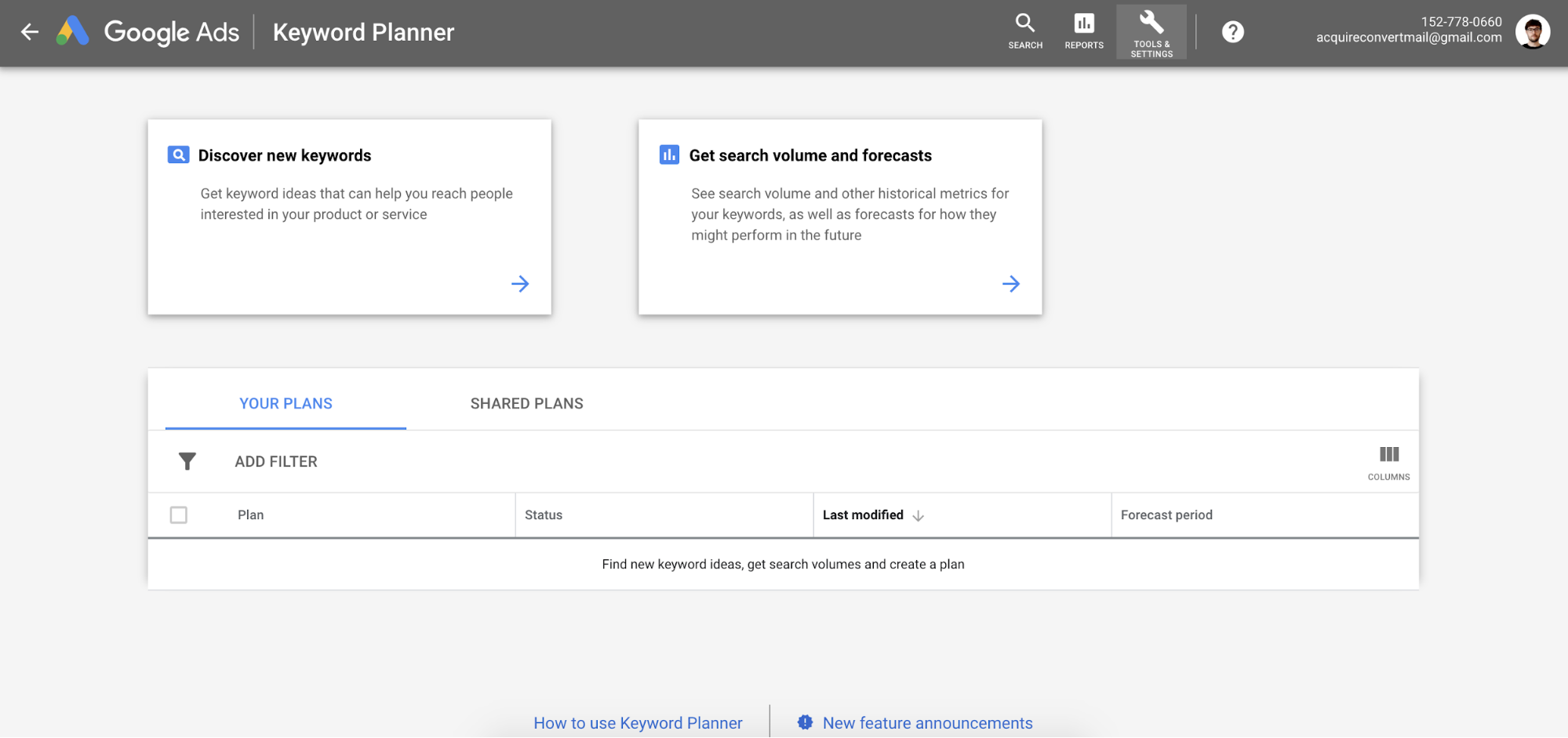
Get keyword suggestions and additional data
Keyword planner offers three ways to get additional keyword suggestions as well as additional information about each keyword in order to determine its usage and competition.
The first is by entering one or more keywords about your product or services. Let’s enter our #1 short-tail keyword.
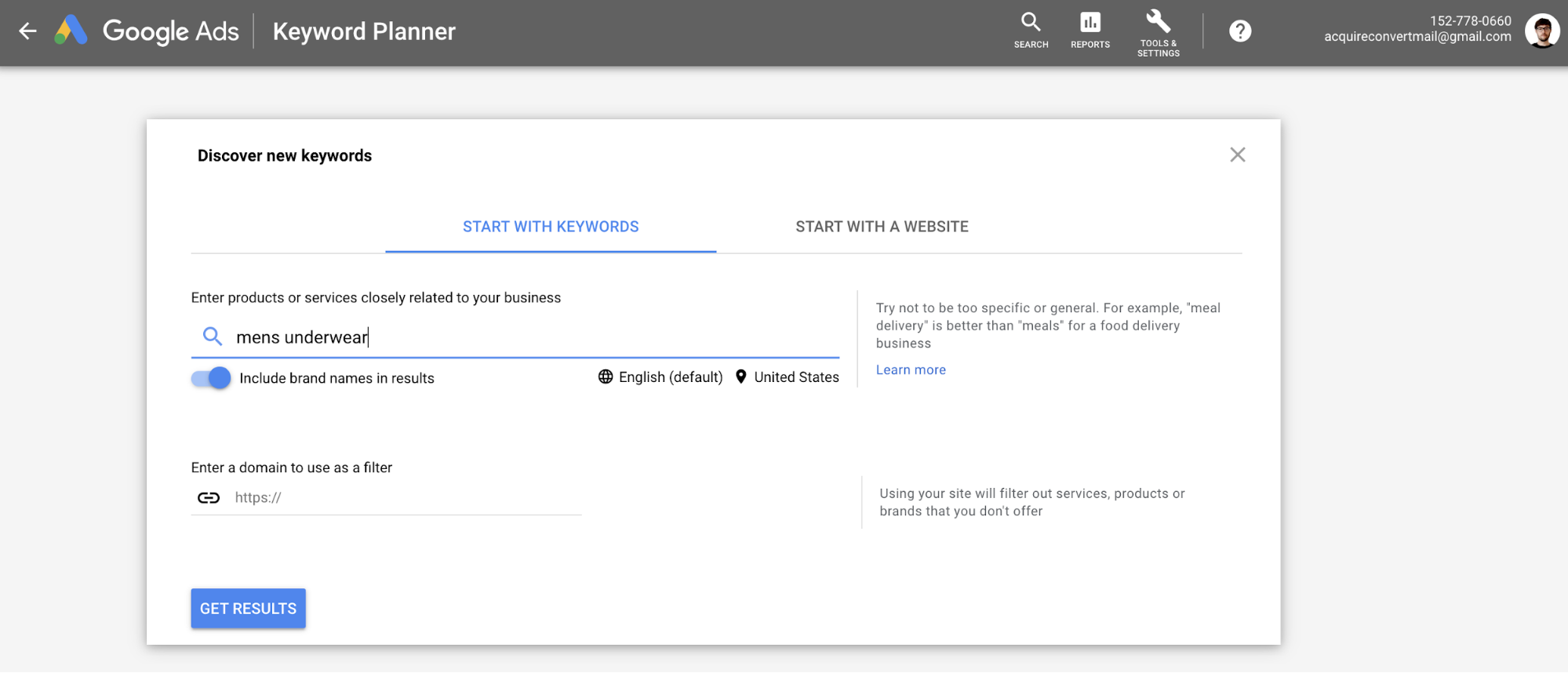
Make sure to check the language and country selection are correct.

You can choose multiple locations, for example if you want to target all English speaking countries. I would advise to have a single country location to target with your SEO at first. We’ll set this up in Google Search console later in the guide.

You’ll get hundreds of keyword suggestions.
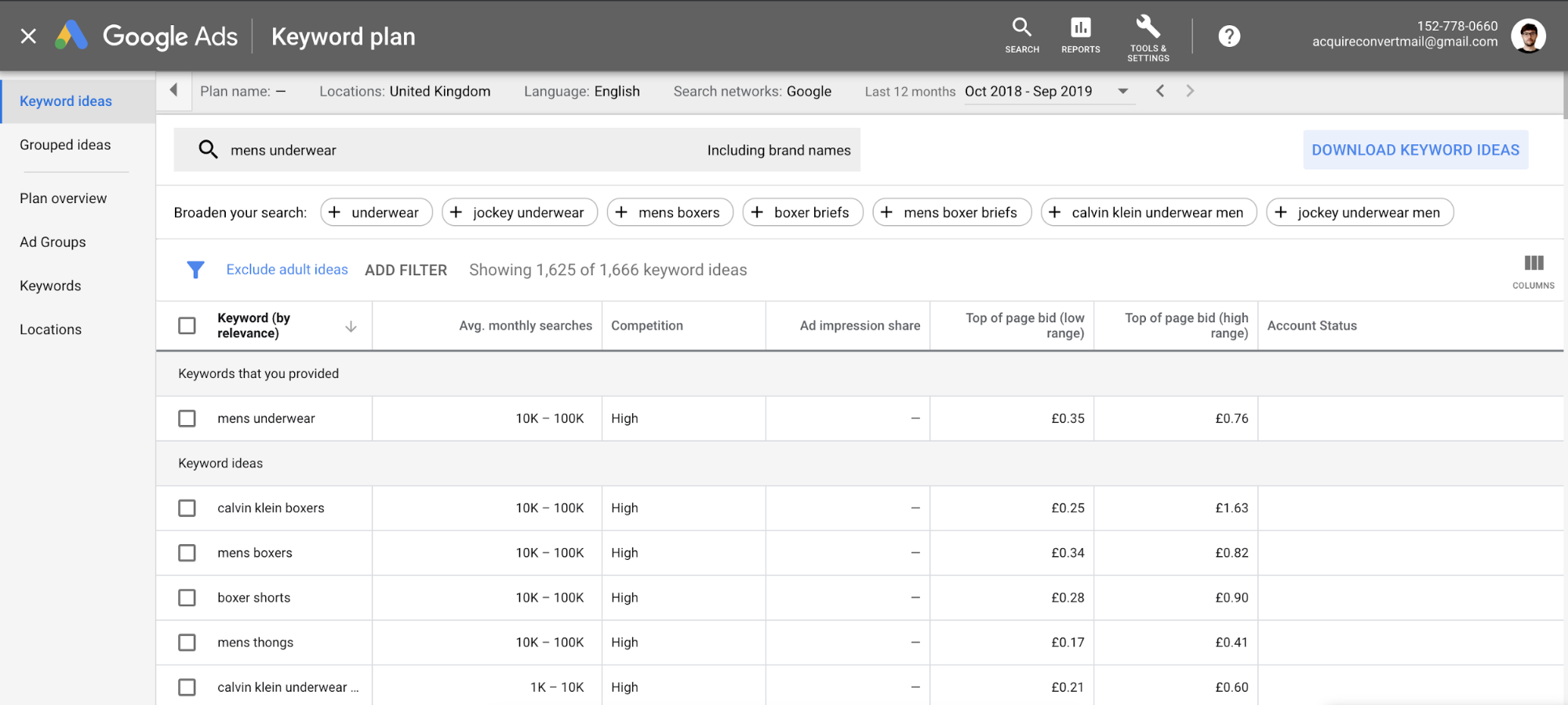
Now you could start to filter them in the keyword planner, but I prefer to download the whole list and complete the filtering process in Ahrefs.
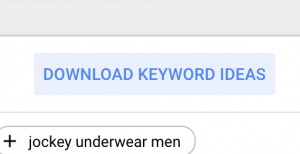
I find the average monthly searches in Google to be inaccurate compared to Ahrefs.

Download the whole list, and then copy and paste just the keyword column into your ‘All keywords’ tab in your Google sheet.

Just drag the file into Gdrive, right click and choose open with Google sheets.

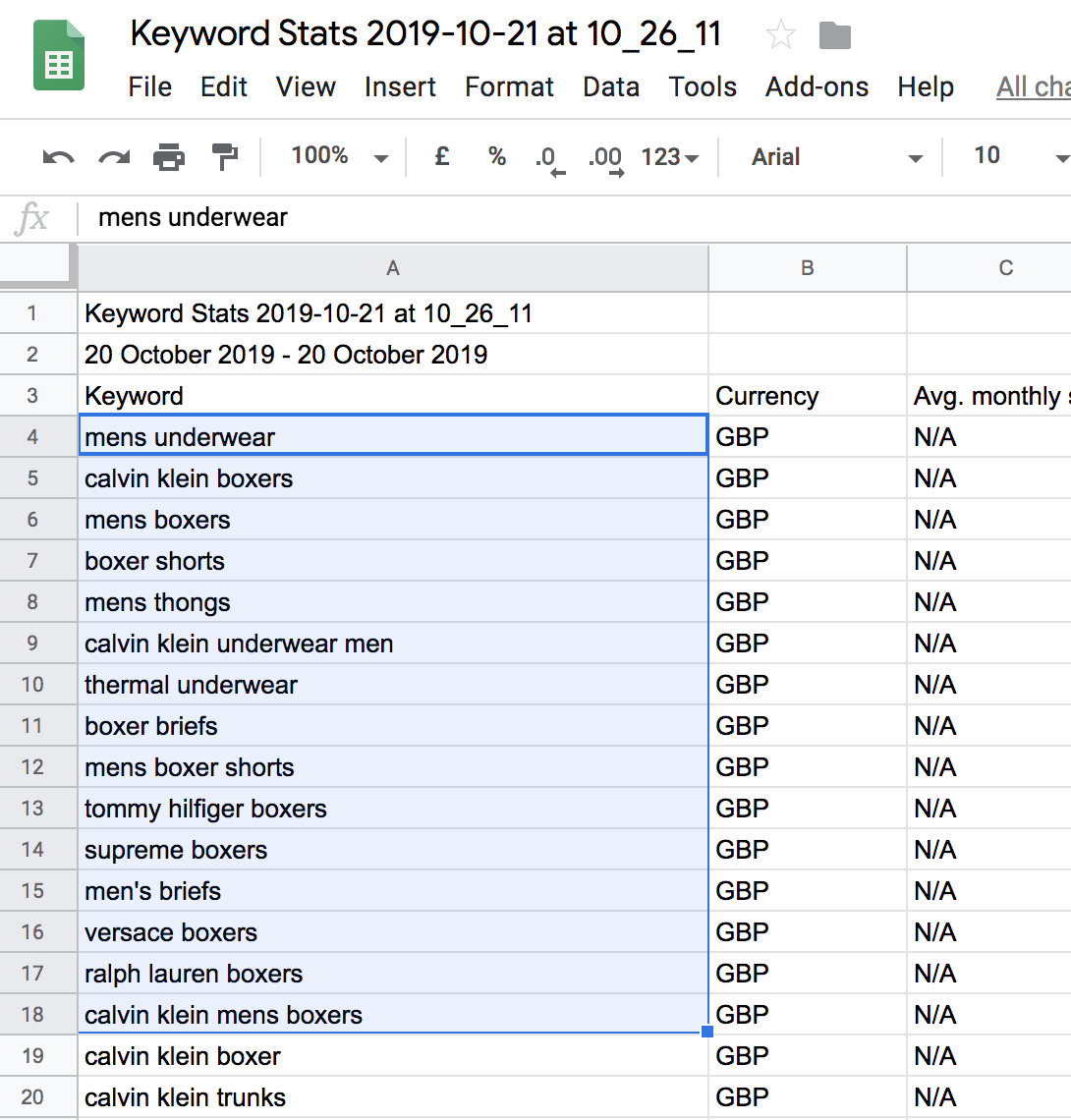
You can repeat this process for your category page keywords to get more keyword ideas.
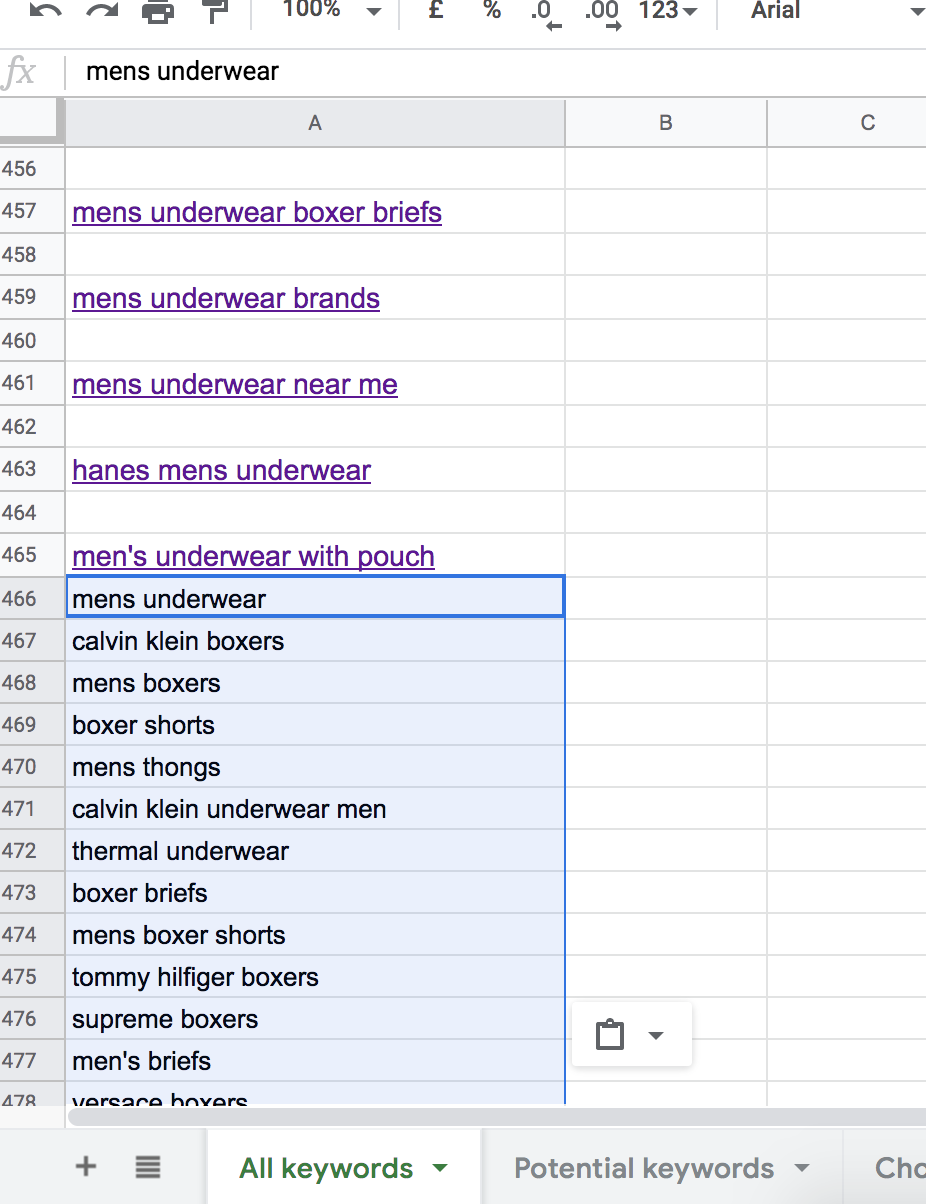
Download, convert your file, copy and paste those to your ‘All keywords’ tab too.
You can also search with a website.
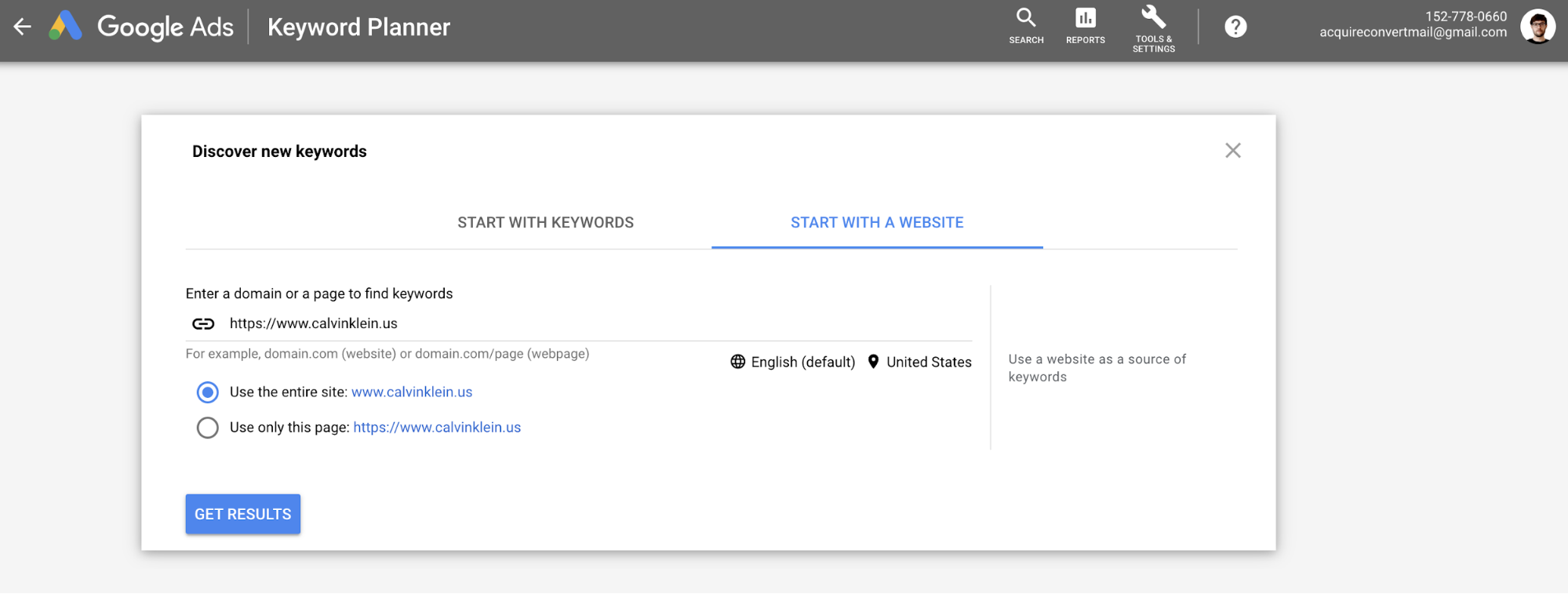
Using a competitor is the best option.

You can then download all the keyword ideas again and add them to your ‘All keywords’ tab in the Google sheet.
NB: You will see the competition level (Low, Medium, or High) based on the number of advertisers creating ads using Google Ads and the suggested bid amount if you were to create an ad targeting people who search for that keyword. This IS NOT the SEO competition level, again we’ll use Ahrefs to determine how hard a keyword is to rank for.
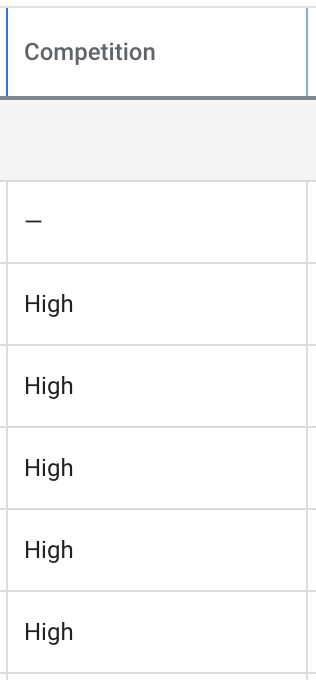
Get additional data about your own keywords
You can also get average monthly search volume from Google ads keyword planner for keyword you already found.

But again, we’ll use Ahrefs for this info as I believe it to be more accurate.
Ahrefs $7 USD for 7 days trial
Next hop on over to Ahrefs.com. (I have no affiliation with them and make no commision from this link)

Get started with the trial.

Choose the standard plan.

Then complete the checkout and activate your account from your email.

I signed up to the free trial for this guide, just so we get the same Ahrefs experience, rather than using my Agency account.
Next go through the set up, you can just fill in the essentials as below for now.
For the sake of the set up, I’ll use a Shopify mens underwear store I found on Google.
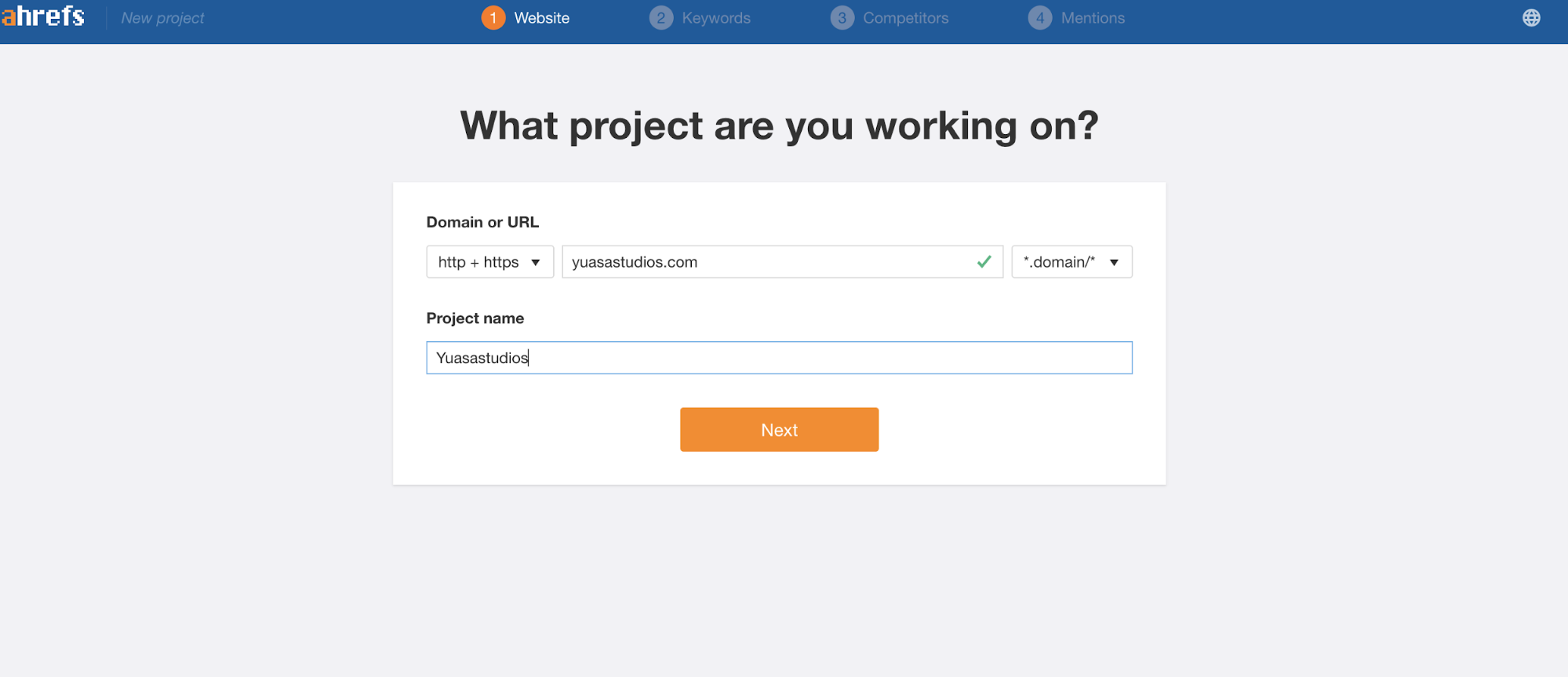



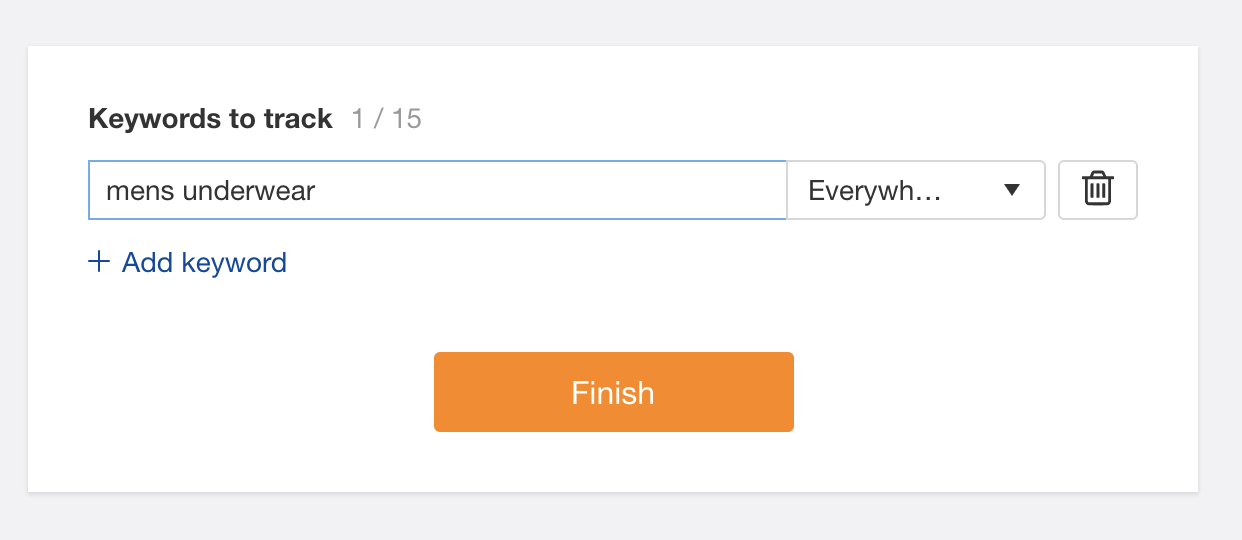
NB: Don’t forget to note your trial expiration one day before in your calendar so you can unsubscribe and avoid further charges as needed.

Now we have access to Ahrefs we can use the keyword explorer, found in the header menu:

Be careful not to start rushing and making keyword searches, because you only get a few per day.

The next step is to search your #1 short-tail keyword and all your category page keyword in the keywords explorer tool to find more ideas, which you can again export and add to your ‘All keywords’ list. We’ll then analyse the complete list in Ahrefs and get the list of keywords for our ‘Chosen keywords’ tab.
Jump into the keyword planner and search your core keyword.

Make sure you check the Google tab and the location setting near the search button.
In the sidebar, focus on two of the options, ‘Having same terms’ and ‘All keyword ideas’.
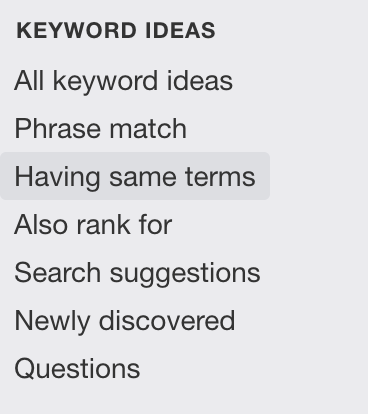
You can then either roughly select the keywords that match your brand or export all the keywords to a CSV. I’d go with the later as we’ll organise and sort keywords in the next step.

Export from the top right.
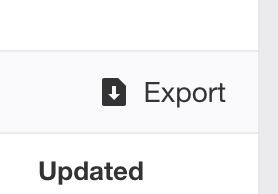
Make sure you DO NOT check the ‘Include SERPs’ option as this will end your export plan limit in one go more or less! You don’t need this info as of right now.
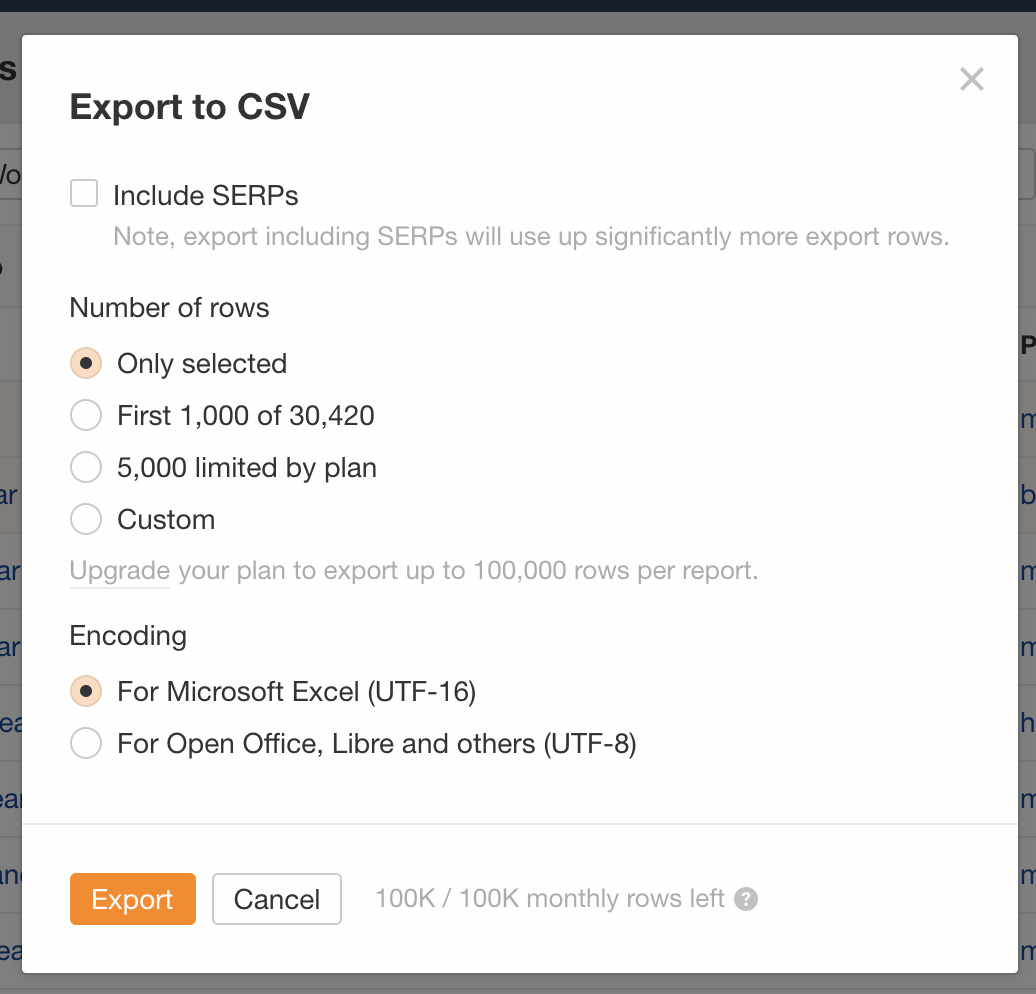
Once you you’ve searched for your main and category page keywords in the keyword explorer and export the results. You can copy and paste them from the CSV into the Google sheet ‘All keywords tab’.
At this point you should have found A LOT of keyword options.
I found 7095 in total.

Before we copy and paste all the keywords we found to date into Ahrefs and analyse them, it’s best we clean up the list.
Duplicate the sheet as a back up.
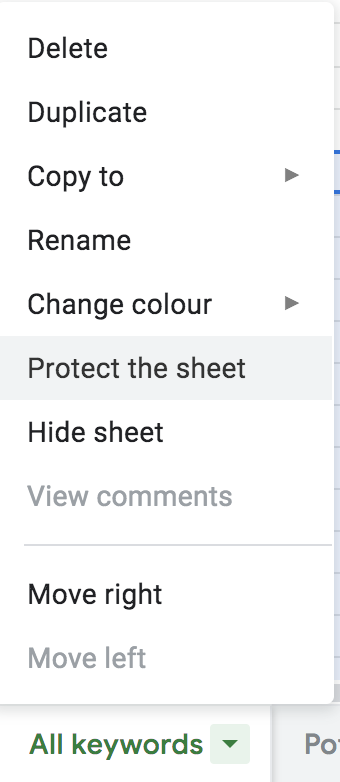

First remove all the blank rows, you’ll need to install this Google sheets add on:
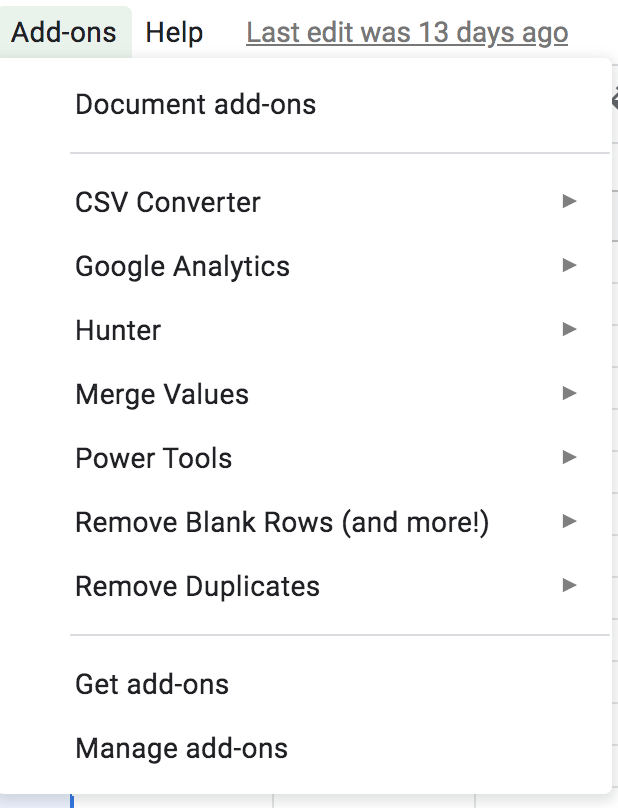
Then click on ‘Add-ons’ in the header menu in G sheets.

And click on ‘Remove blank rows’, then ‘Delete/hide blank rows/comuns’.

Choose to delete them.
Then you need to install this Google sheets add on called ‘Remove duplicates’:
Then you can select the whole column in G sheets and click on ‘Find duplicate or unique rows’.

Choose duplicates:
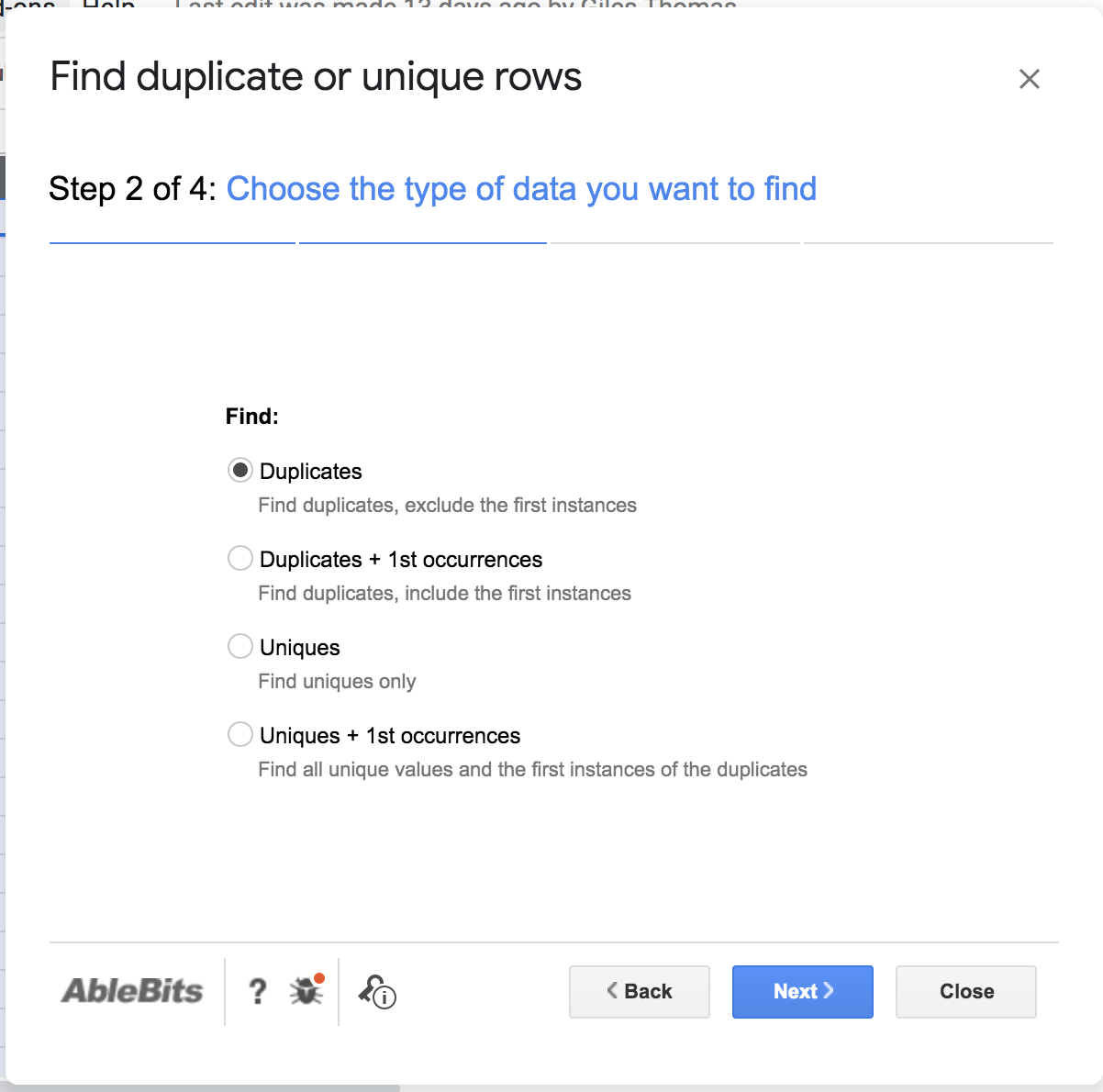
Check if you column has a header, you do not need to check ‘Match case’ You can leave ‘Skip empty cells’ checked.
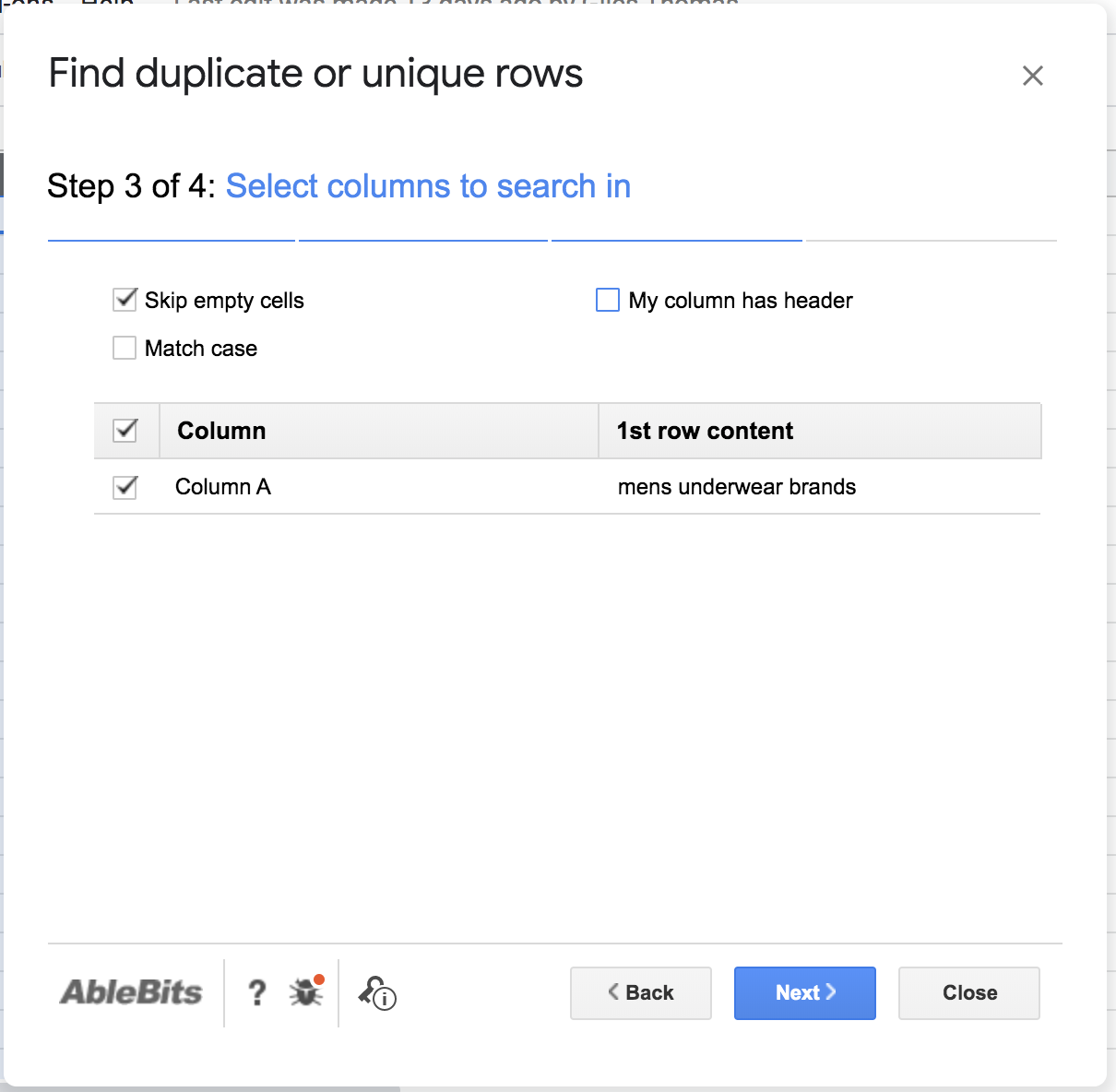
Choose ‘Delete rows within selection’ as we already have a back-up of all your keywords.
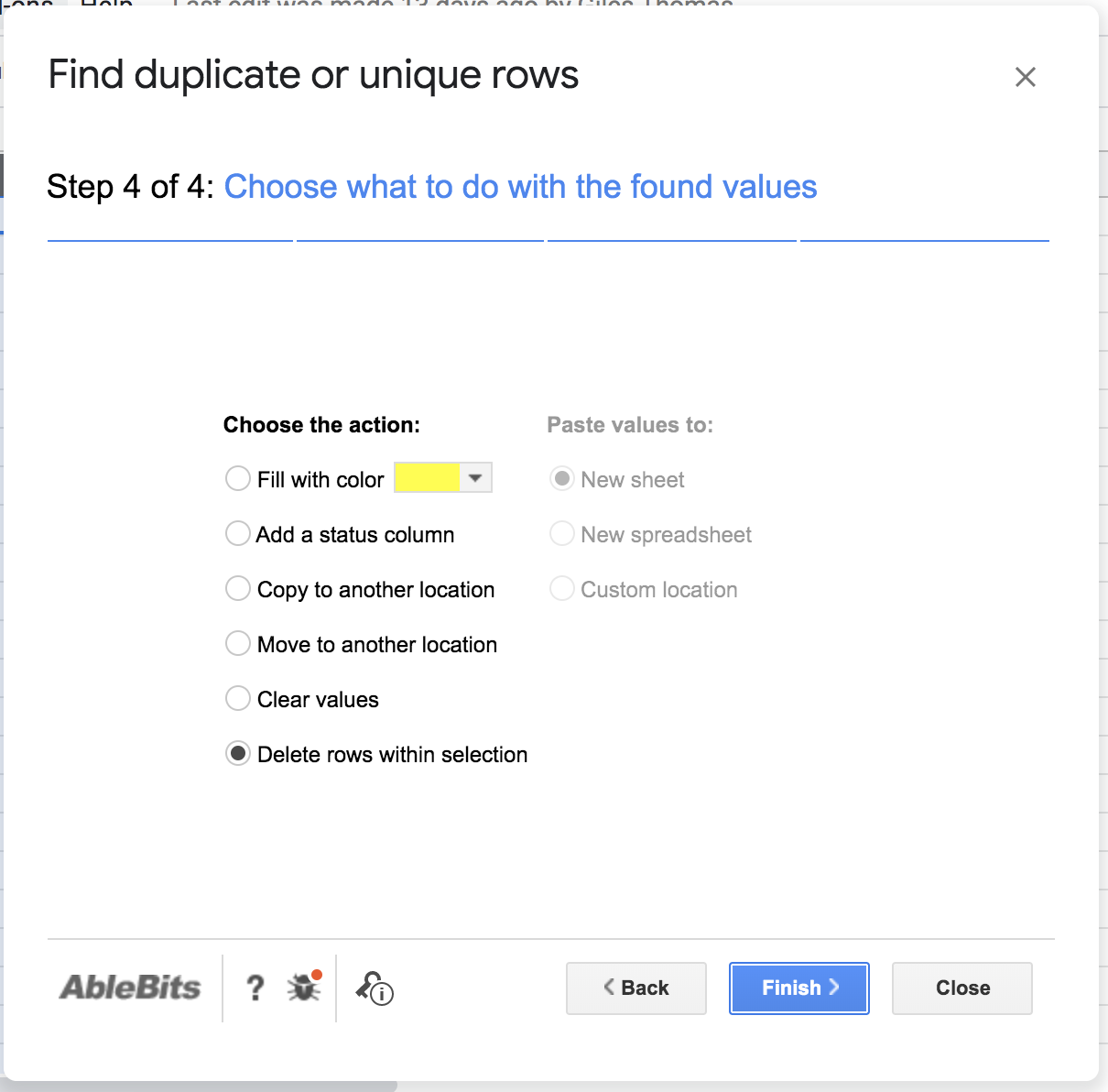
Now you are left with no spaces and only unique keywords.
Then next steps is to create a keyword list in Ahrefs so we can analyse and save the Potential keywords’ for our Shopify store.

Navigate to the keyword explorer tab again and scroll to the bottom to the keywords lists section.
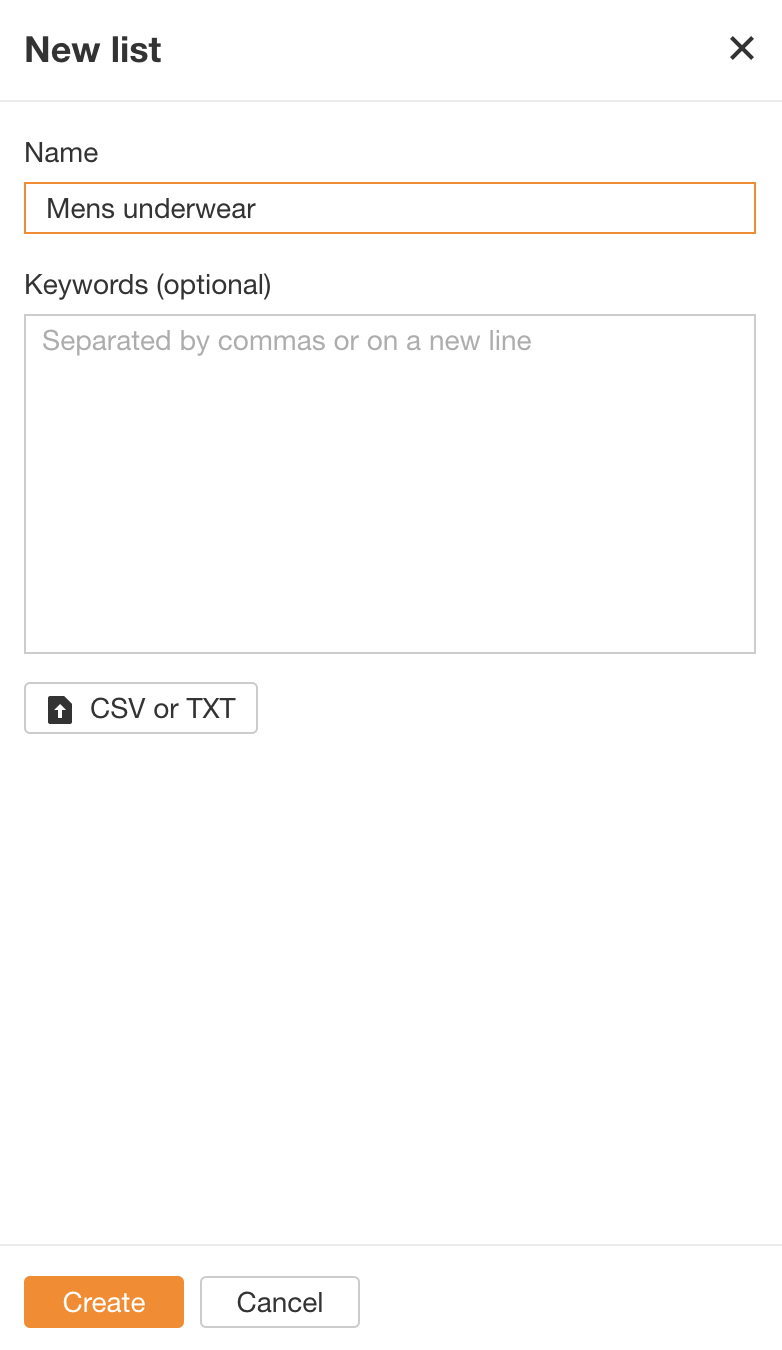
Create a new list and name it.

Now we have a place to save our ‘Potential keywords’.
The next step is to copy all the keywords from your cleaned up ‘All keywords’ tab and paste them into the Ahrefs keyword explorer tool.

The first thing you will notice is that you can’t find keyword data for some of the keywords. That just means they don’t get enough monthly searches to care about, so don’t care about them. Moving on.

So know you’ll see all your keywords loaded up with keyword data in Ahrefs, this is the exciting part!
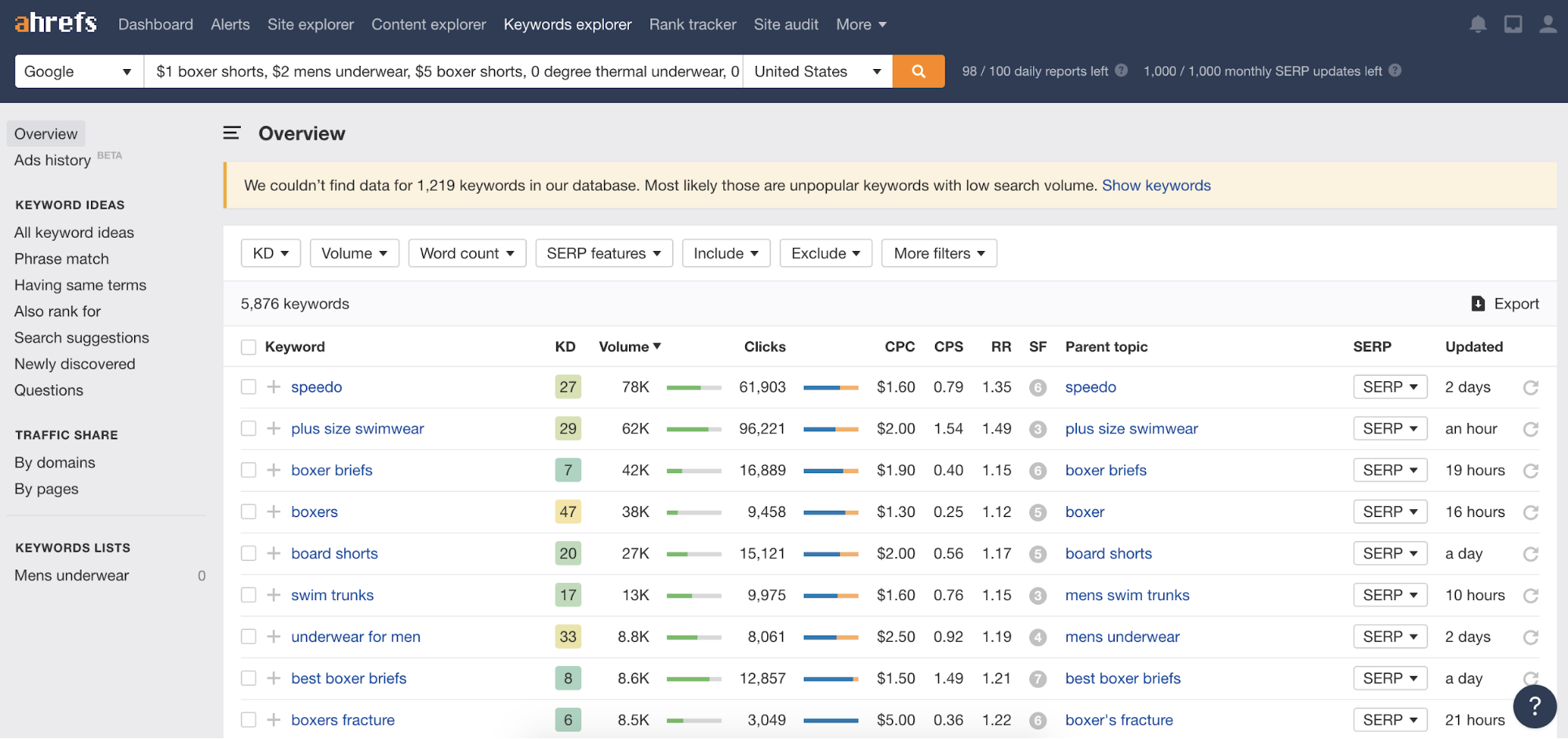
Before we start going through and show you how to add keywords you want to save to your list, let’s first recap some of the terminology we learnt in the basics section as it applies to the Ahrefs interface.
‘KD’ means keyword difficulty. As Ahrefs says: ‘Keyword Difficulty estimates how hard it will be to rank in the top 10 organic search results for a given keyword in a given location.’
‘Volume’ is how many people search for that keyword per month in your selected country.
‘Clicks’ is how many of the searches turn into clicks.
‘CPC’ is how much people pay for Google ads for those keywords. A good indicator of whether a keyword can drive revenue to a business. Obviously keywords people spend more on have a higher chance of being ‘buying intent’ keywords. But also a higher chance of being competitie to rank organically for.
‘Parent topics’ can help you to structure your site and understand keyword hierarchy in your niche. We’ll get to that in the ‘Site architecture’ step next.
‘SERP’ is a great way to see what the rankings look like now.
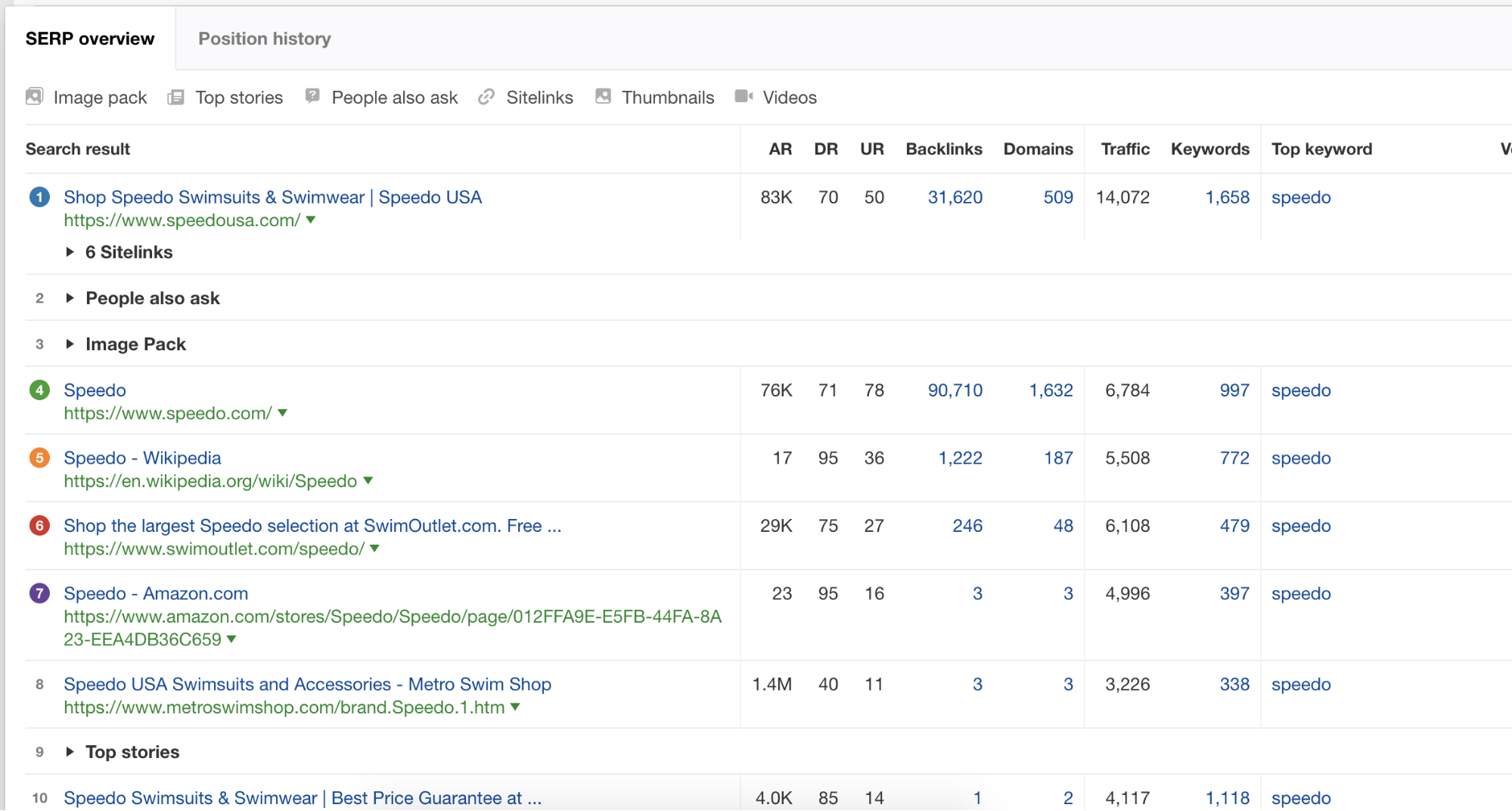
You need to be cautious of keywords where the KD looks low, but when you open the SERP the top ten results have DR (domain rank as you might remember) of 70-80+.
You should always eyeball the SERPs of a keyword before committing to it. Don’t just take the KD on face value.
With that info let’s skim through a few example results and choose if we want to target those keywords.

First keyword is ‘Speedo’, a branded keyword so we’ll skip that.

Next up ‘boxer briefs’ is perfect, some would leave out ‘boxers’ as it is too high KD at 47. But I’d add all those keywords in for now, we can imply choose not to assign them to a page in the third tab ‘Chosen keywords’.

Check for sex based queries, if you are focused on one gender, skip keywords that don’t match.

Also watch out for location based keywords, unless you have or plan on having a brick and mortar store, these keywords can be left out also.

Also look out for colors, if you already know your product color variations.
As a rule of thumb I’d choose keywords from 0 – 20 KD for a brand new domain, 0 – 10 being the KD level you likely have any chance of ranking for. I’d also skip keywords with less than 150 monthly searches, unless they exactly match a product or product category.
Now spend some time reading through every keyword, if the keyword fits check it, at the end of each page, scroll to the top and add the keywords to your list.
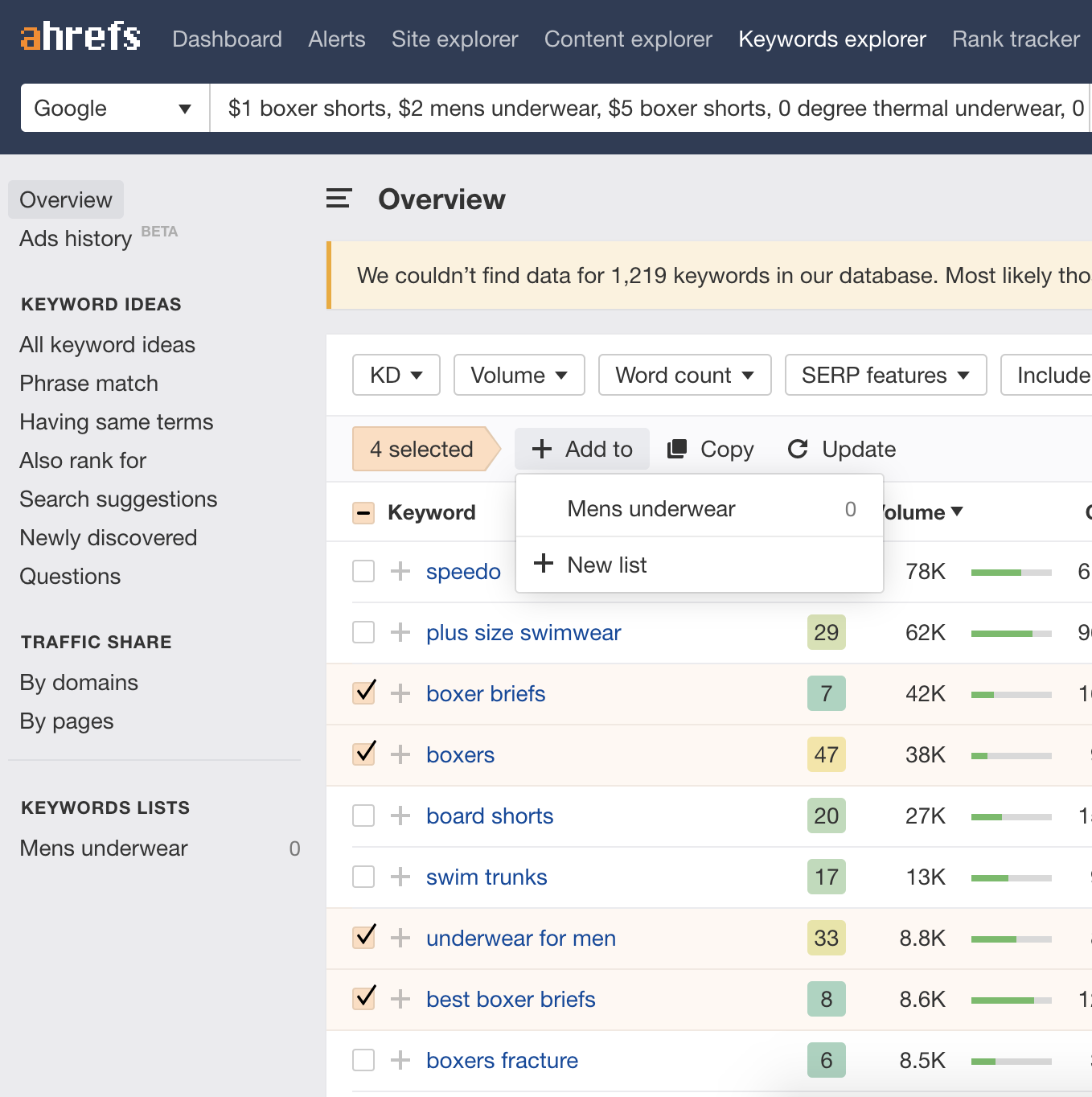
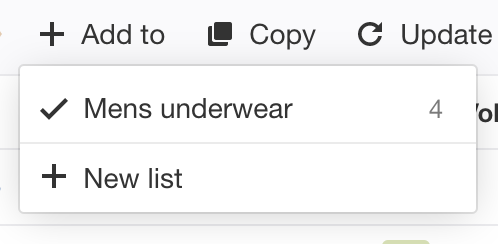
Once I sorted through all the keywords I had 268 keywords to export.
Once you are done, click export in the top right and (leaving include SERPs unchecked) choose all rows and Microsoft excel then export.


You can now copy and paste the whole export into your ‘Potential keywords’ tab like this.
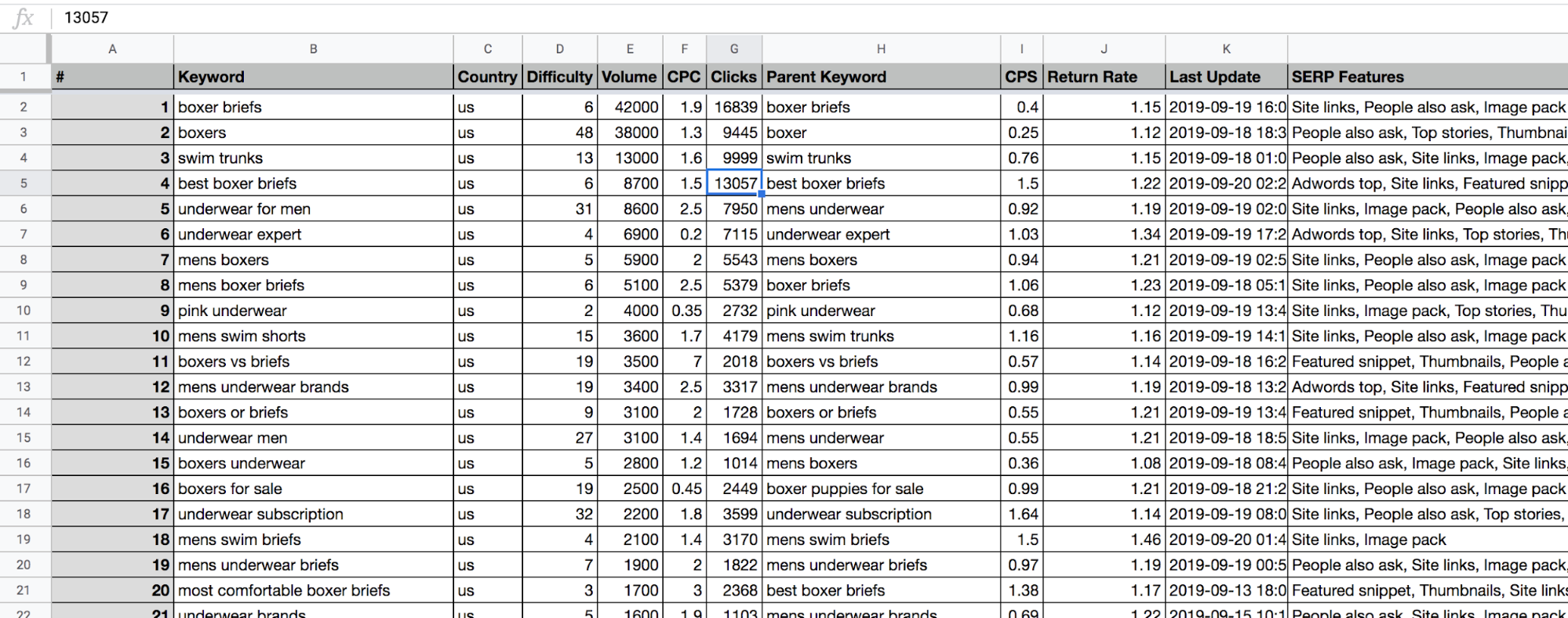
As I mentioned my final list of potential keywords was 268.
A lot less than the 7k of keywords we originally found.
This is because some keywords were too low volume, some to high competition. Some didn’t match the brand or mentioned competing brands (useful for PPC).
The next step is to match the homepage and all the category and products pages we added to the ‘Chosen keywords’ tab to keywords from our list.
You will also typically find keywords that work well for sales events and blog content which we can group together.
The selection process is quite simple.
First freeze the top row.

Then order the ‘Volume’ column Z – A.
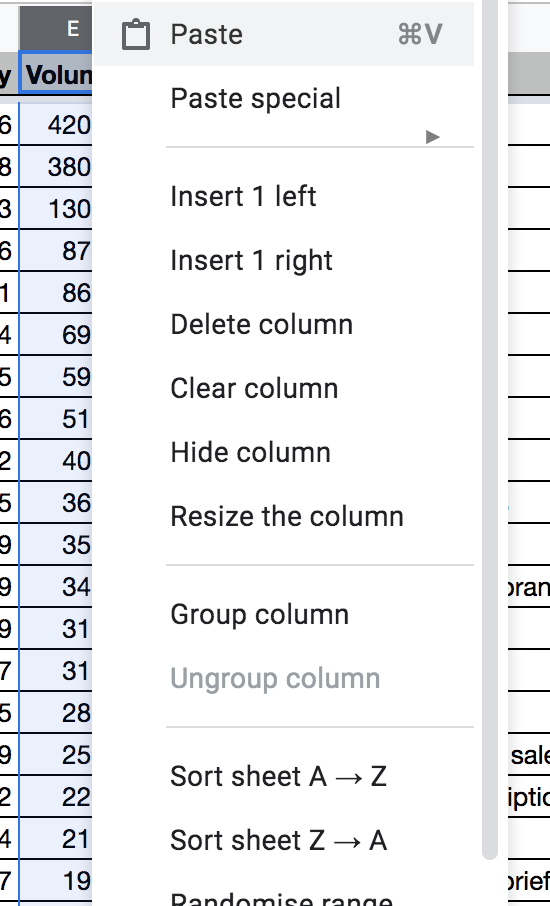
Now start to scan down the keyword list and look for keywords with difficulty less than 10.

The first keyword fits this bill and has a huge search volume.
You’ll want to cross reference this difficulty score by looking at the SERPs in Ahrefs to make sure that it’s a fair score of competition level.
‘boxer briefs’ is quite short tail and I doubt it’s a level 6 to rank for!

As you can see most of the sites are in the DR 80-90s. Including Amazon, Macy’s and Calvin Klein. Unless you have an enterprise budget or venture capital for SEO you can forget ranking for this keyword.
So we won’t be assigning this keyword to a page.
Continue to run through the list and start to mark good keywords into potential choices for the homepage, collection pages, products pages, blog content and sales pages.
Mark them green so you can find them later.

You don’t have to choose the final keyword to focus each page on yet. You can simply mark them green for one more final review and selection process.
Think of this step as another filter before the final pick. A short list so to speak.
Again focus on the highest volume keywords with the lowest competition. Don’t forget to check the competition level by eye in the SERPs in Ahrefs.
Collection page keywords will typically be plural or describe a group of products. For example: ‘mens designer boxers’. Where as a product page keyword will describe an individual product often with a modifier. For example: ‘red swim shorts’.
Also think about product / keyword fit. How closely does the keyword match the product you are selling. You need to balance between search volume and fit. Longer tail keywords than more accurately and exactly describe your product will typically have lower search volumes. Although this is changing with voice search, more on that in the advanced section below.
The final step in the selection process is to pick one keyword for each page from your keywords that are marked green and paste them next to the product in the ‘Chosen keyword’ tab.

Fill up the ‘New url’, ‘Difficulty’ and ‘Volume’ tab with data for all the products, collection pages and homepage.